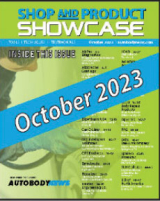In today’s collision industry environment, many shop owners and managers are finding competent staff are becoming a scarce and valuable commodity. In response, progressive companies are looking for ways to differentiate themselves to be the “employer of choice” in their marketplace, according to Tim Ronak, senior services consultant at AkzoNobel.
One option is to implement a four-day workweek.
“A four-day workweek can be a powerful recruiting tool that positively impacts facility morale, helping to foster an environment to becoming an ‘employer of choice,’” he said.
Ronak and Tony Adams, a business services consultant at AkzoNobel, discussed the potential benefits and challenges of this alternative structure during the AkzoNobel Acoat Selected North American Performance Group event in Orlando, FL, in March. They also presented the idea during a presentation held as part of the Society of Collision Repair Specialists (SCRS) Repairer Driven Education Series at the SEMA Show in Las Vegas, NV, in November 2023.
“It typically involves reducing the workweek from five days to four while maintaining the same number of weekly working hours,” explained Ronak. “However, it can mean different things to different stakeholders.”
In the European Union (EU), for example, the alternative structure can imply four eight-hour days, resulting in a 32-hour workweek. However, in the U.S., Ronak said businesses typically work four 10-hour days to maintain a 40-hour workweek.
Ronak shared information about an EU study conducted in June 2022 that evaluated the merits of a four-day work week. Over six months, 61 organizations reduced their work hours by 20% with no pay decrease.
“They found that it boosted employee well-being without comprising productivity,” he said.
Participating companies reported a 65% reduction in sick days and a 57% decrease in staff turnover. At the same time, 71% of employees reported lower levels of burnout and 39% said they were less stressed compared to the beginning of the trial. This resulted in 92% of the companies planning to continue with a four-day work week; 18 companies said it would be a permanent change in their business.
Ronak noted the work schedule variations implemented by the organizations. While some stopped work entirely for a three-day weekend, others staggered a reduced workforce over a week. A selection of participants designated fewer holiday days and others set an agreement that staff could be called in at short notice. Some decided that a “conditional” four-day week would only continue while performance targets were met.
The study found most employees used the extra time off as “life admin,” spending the day doing tasks such as shopping and chores and taking care of family obligations.
“Many explained how the extra time off allowed them a proper break for leisure activities on Saturday and Sunday,” noted Ronak.
Ronak shared information about the United Auto Workers contract negotiations in September 2023, which included the demand for a four-day, 32-hour workweek. Although the new structure wasn’t part of the contract terms, the union is reportedly still interested in the idea.
Ronak also addressed the role of efficiency with a four-day workweek and examined whether it can be achieved in fewer hours.
“With a 20% reduction in hours worked, you would need a 25% increase in productivity to maintain the same output as before,” he noted. “How can people at their peak work fewer hours and still create the same output when you shift to four-days?”
He explained 40 hours worked at 125% efficiency generates 50 hours of output; 150% efficiency equals 60 hours of output for 40 hours of effort. Having employees work 32 hours with the same amount of output, Ronak said they would need to work at 156% efficiency for 50 hours of output and 187% efficiency with six hours of output.
With one less day of coffee or lunch breaks during the week, Ronak said there are fewer stop-and-start intervals, potentially allowing for more productivity.
“The fewer breaks and the longer days seem to drive efficiency,” he said.
Adams then talked about the pros and cons of the alternative work schedule. Potential advantages for employers include increased employee retention and productivity, cost savings, a positive impact on company culture and enhanced employee morale, and a reduced carbon footprint with less commuting.
“We're all vying for people right now,” said Adams. “It becomes a differentiator in the workplace if everybody around you is working five days a week and you're able to give employees the gift of 50 more days a year, more time with their families and an extra day to do some activities.”
Advantages for employees include improved work-life balance, increased productivity and focus, and reduced commuting time driving in off-hours.
“We're giving employees the gift of less commuting, and they're saving money because they're driving back and forth four days a week instead of five,” he said.
Another employee advantage he pointed out is technicians having fewer starts and stops.
“Sometimes, we miss the energy burden that technicians go through with the start-stop, start-stop dynamic,” noted Adams.
Overall, the altered work schedule was found to enhance employee morale and satisfaction.
Adams also addressed the challenges of a four-day workweek. For employers, these include extended daily work hours, the potential for decreased productivity and resistance from management, client and customer expectations and issues, including billpayers, implementation costs, and coordination and scheduling complexities.
“It’s a hard shift for some of us serial entrepreneurs who are trying to figure out how to maximize the efficiency of our facilities,” said Adams.
Challenges for employees include longer workdays, the potential for burnout, difficulty adjusting and reduced opportunities for overtime pay.
Adams said there is no one-size-fits-all scenario and encourages owners and managers to consider the pros and cons before deciding what is best for the facility.
“Care must be taken to ensure that facility output is maintained or improved and that formal structure is enforced so customers and vendors are clear regarding facility operating hours,” he said.
Implementation Tips
For shops evaluating a four-day work week, Adams and Ronak shared these tips:
- Select the specific alternative structure: Decide on a flexible or fixed schedule, implementing a 40-hour week with four 10-hour days or a 32-hour week with four eight-hour days. Other options include extended hours or multiple shifts.
Prepare the team: Be transparent when communicating changes with employees. Look into state and federal employment laws, as well as overtime pay rules. Also, evaluate training needs.
Logistics: When deciding on the best schedule for the facility and how it will be implemented, consider office hours of operation versus production hours of operation.
Tools: Contemplate work schedule and pay structure tools, including vacations, statutory holidays and sick time.
Auditing and compliance: In addition to legal and regulatory compliance issues, plan how the business will monitor production targets and approach new team member integration.
Read case studies from Kena Dacus, owner of Dacus Auto Body & Collision Repair in McPherson, KS; Stephen Bozer, owner of Fix Auto Tempe in Arizona, and Mitch Erlacher, location manager of Stinnett’s Auto Body in Maryville, TN. All three discuss their experiences after implementing a four-day work week.










Stacey Phillips Ronak